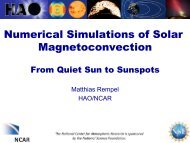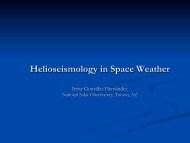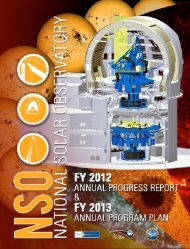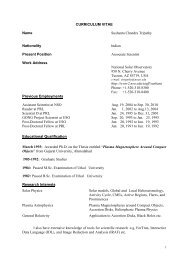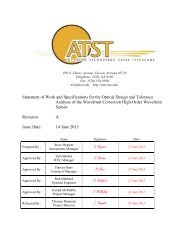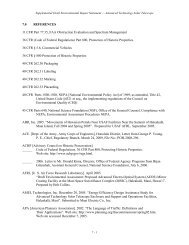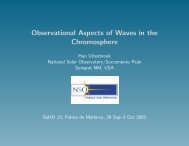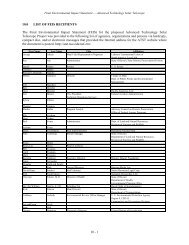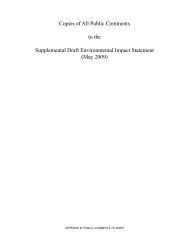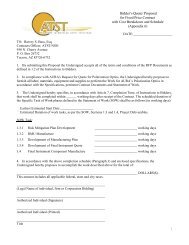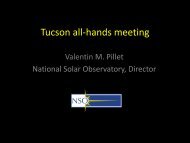Cultural Surveys Hawai‘i Job Code: HALEA 2Community Contacts and Consultationspay respects to ancestors and the different Hawaiian deities. He uses the two Ahu. He alsodescribes the significance of Paeloko, a coconut grove located at Waihe‘e in which the sennitfrom this particular coconut grove was used to make the lasso or cordage that Maui used to snarethe sun.In an e-mailed letter, Mr. Rayomond suggests having an English translation of the welcomesign (currently only in the Hawaiian language) at the entrance to Science City. He explains thatthe majority of Hawaiians cannot read Hawaiian and therefore may not know they are allowed inthis area. He says signs in both English and Hawaiian would allow the public to understand whocan enter and for what purpose.6.1.9 Mr. Sam Ka‘aiMr. Ka‘ai explained that Haleakalā is a sacred mountain and that “sacred mountains arepraying places.” He explains that it is hard to pray when you have helicopters flying overhead,thousands of cars and tourists, and large telescopes all around your praying place. He describesthe great pain that the Hawaiian people experience when a sacred place such as ‘Īao or Haleakalāare desecrated as these have been. He relays his frustration with the laws requiring culturalimpact assessments and the section 106 process. He explains, people take their time and sharetheir knowledge only to find that it doesn't make a difference in the outcome of a project. Mr.Ka‘ai explained that these people increasingly feel they are wasting their time, because, hestresses, “no one listens!” Mr. Ka‘ai spoke of the rock at Haleakalā that marks the point wherethe eight Moku of east Maui meet and speaks of its importance in Hawaiian culture. He alsomentions Pa‘a Kea, a rock or rock mound where priests would go on the summer solstice to pray.He talks of Pu’u Ula, explaining that it is also called Red Hill or Sacred Hill. Mr. Ka‘ai states thesummit area of Haleakalā is where angels walk and was kapu to commoners. Lastly Mr. Ka‘aimentions that his family used to own land from Palikū, down the mountain.6.1.10 Mr. Kawika DavidsonMr. Davidson is the president of Kahikinui Game and Land Management. This group hasrights to access the Kahikinui Forest Reserve for the purpose of hunting and gathering plantsfrom the area. Mr. Davidson relays his knowledge of Haleakalā as wao akua, “a fragile part ofthe upper forest to the summit.” He explains that in traditional times this area was kapu to allexcept ali‘i, kahuna and messengers. Mr. Davidson describes using the Skyline Trail for accessto hunting grounds. He hunts goats, pigs, deer, pheasant, chucker and other variety of gamebirds. He also says that he uses this area to collect ‘ōhelo berries, ferns, pūkeawe, pōpolo,māmane and ‘a‘ali‘i. Mr. Davidson uses the plants for a variety of purposes and hunts for food.He recalls, that traditionally only certain parts of the forest could be accessed by man. Mr.Davidson feels the proposed <strong>ATST</strong> will be an eyesore.6.1.11 Mr. Timothy BaileyMr. Bailey is a Haleakalā National Park (HNP) employee of 16 years. He currently heads theFeral Animal Removal Program. In his time employed at HNP, Mr. Bailey has had theopportunity to hike the entire crater rim, traverse the carter, and has accessed the surroundingslopes of Haleakalā . Over the years he has become intimately familiar with the greaterHaleakalā region. He shared some of his cultural knowledge of the area with CSH staff.APPENDIX F (2): Supplemental Cultural Impact Assessment For the Proposed AdvancedTechnology Solar Telescope (<strong>ATST</strong>) at Haleakalā High Altitude ObservatoriesTMK (2) 2-2-07:00897
Cultural Surveys Hawai‘i Job Code: HALEA 2Community Contacts and ConsultationsMr. Bailey began by describing the Pohaku Palaha, a flat, circular plateau that marks the“piko” of east Maui. This is the spot where all eight east Maui moku meet. It is located at the topof the northeastern rim of the crater, at Lau‘ulu Paliku. Its name is said to represents the he’e, oroctopus, and describes how the he‘e clings on to a rock when hiding or when being hunted. Itseight tentacles spread out over the rock and its mouth, its center, representing the piko, locksonto the rock making it extremely difficult to pry loose. Like the tentacles of the he‘e spread outover a rock, Pōhaku Pālaha is the piko from which the eight east Maui moku fan out.Mr. Bailey went on to describe the migration pattern of the ‘ua‘u. He explained thatHawaiians observed animals’ migration patterns and used them in combination with other naturalcycles to keep track of seasons and time. It was known that when the koholā or humpback whale,left Hawaiian waters, the ‘ua‘u would be arriving to nest and when the ‘ua‘u left, the koholāwould be returning. Therefore, Hawaiians knew not to waste their time hunting for ‘ua‘u whilethe koholā were still around. Mr. Bailey explained that a mother ‘ua‘u is referred to as kaini andtraditional hunters were careful not to kill as they were needed to raise their young. Although‘ua‘u chicks and males were hunted for food, traditional hunting practices made sure populationscontinued to thrive.Mr. Bailey explains that ‘ua‘u were hunted for food and for feathers. They were eatenexclusively by the ali‘i, and their feathers were used as adornments for hula and lua instrumentsas well as feather capes. ‘Ua‘u and ‘ua‘u feathers were the hō‘ailona, or the insignia of someali‘i. And in the same way feather cape patterns identified the rank of an ali‘i, the particularcolor of the feathers also indicated the rank of an ali‘i. ‘Ua‘u were also the ‘aumakua, or familygod, of some families. Birds were caught using snares and basket traps. In a third technique, astick was used by inserting it into the burrow and placing it into the birds downy feathers. Onewould then twirl the stick and the feathers or huluhulu would become entangled around the stickand the bird could then be pulled out. Mr. Bailey referred to this as “wiliwili the huluhulu”. Mr.Bailey noted the many sling stones he has observed in the crater. He thinks they might have beenused for hunting ‘ua‘u. Their name, he believes, is simply the sound of their call, ‘ua‘u.Mr. Bailey continued to describe some ‘alaea (“red ocherous earth”; Pukui and Elbert1986:17) pictographs located near Kapalaoa Notch. He has studied these pictographs and thinksthey look like ‘ua‘u birds. He also described a variation of the place name Kapalaoa. He said hehas known the area as Ka palaoa, two words meaning the palaoa, likened to the prized whaleivory pendant, lei palaoa. Ka palaoa Notch, he explained, is a notch in the cliffs of that areashaped like a palaoa pendant. Mr. Bailey also described a spring that feeds the Kapalaoa cabincalled Wai palaoa and a heiau located atop Kapalaoa ridge.During his time with the park service, Mr. Bailey has noticed what he believes are oldHawaiian trails. Trails, he states, that are well made and have managed to withstand the ages.Mr. Bailey believes that one trail in particular follows the flight path of the ‘ua‘u from the oldfishing village at Nu’u, to their nesting ground at Haupa‘akea, on the southern rim of the crater.He has followed sections of the trail on foot and from a helicopter. He has hiked fromHaupa‘akea to Nu‘u in a day’s time proving that Hawaiians could get to Haleakalā Crater andsummit area fairly quickly. Mrs. Kathleen Bailey, Mr. Bailey’s wife, is a wildlife biologist atHaleakalā National Park. She noted that there are 27 active ‘ua‘u burrows at the preferred Meessite location.APPENDIX F (2): Supplemental Cultural Impact Assessment For the Proposed AdvancedTechnology Solar Telescope (<strong>ATST</strong>) at Haleakalā High Altitude ObservatoriesTMK (2) 2-2-07:00898



